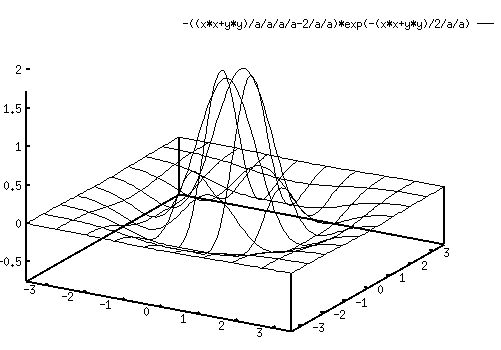![\begin{displaymath}G(x,y)=c\mbox{ }exp[-\frac{x^2+y^2}{2\sigma_c^2}] \end{displaymath}](img41.gif)
First we consider modeling the RF in the Space Domain. The center-surround
RFs of the retina ganglion cells can be mathematically modeled in either
of the following ways, both starts with 2D Caussian function defined as
![\begin{displaymath}G(x,y)=c\mbox{ }exp[-\frac{x^2+y^2}{2\sigma_c^2}] \end{displaymath}](img41.gif)
| f1(x,y) | = | Gcenter(x,y)-Gsurround(x,y) | |
| = | ![$\displaystyle k_c\mbox{ }exp[-\frac{x^2+y^2}{\sigma_c^2}]-
k_s\mbox{ }exp[-\frac{x^2+y^2}{\sigma_s^2}]$](img46.gif) |

 .
.
| f2(x,y) | = | ||
| = |  |
||
| = | ![$\displaystyle [\frac{x^2+y^2}{\sigma^4}-\frac{2}{\sigma^2}]
exp[-\frac{x^2+y^2}{2\sigma^2}]$](img51.gif) |

This 2D function is someitmes called the impulse response function of the cell, although with a little different definition. (Impulse response funciton is usually defined as the time or spatial invariant response to an impulse.)
With certain simplifications, the cells can be assumed as linear systems.
And a cell's response to a 2D stimulus (an image) s(x,y) located at a
spatial position (0, 0) can be found as the weighted sum (integral):
The same 2D stimulus s(x,y) located at a different spatial position (say, by
shifting) (u,v) can be represented by
s(x-u, y-v), and the response to
this stimulus becomes a function of the spatial location of the stimulus: